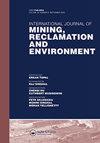Investigation of optimal surface paste disposal design based on crack intensity
IF 2.6
3区 工程技术
Q3 ENVIRONMENTAL SCIENCES
International Journal of Mining Reclamation and Environment
Pub Date : 2023-07-05
DOI:10.1080/17480930.2023.2232987
引用次数: 0
Abstract
ABSTRACT There are many factors affecting the mechanical and geochemical stability of the surface paste disposal (SPD) method. The most important of these are the cracks occurring during the storage of tailings. The relationship between the volumetric water content (VWC), matrix absorption (MS), and oxygen (O2) values of the paste material are important in the formation of cracks. In this study, surface crack formations of the paste material stored at the laboratory in accordance with 3 different storage methods (cemented and uncemented) were observed during the pour and after the deposition, and crack intensity factor (CIF) was measured. The relationship between CIF with VWC, MS, and O2 parameters was examined. As a result, the CIF value decreases approximately by %75 with cement addition in the lowest and highest layers in the SPD method. In a case receiving the most rain, the crack intensity value of the highest layer was determined to be 3,9% in the Design 3 where cement was used in the lowest and highest layers. In addition, VWC, MS, and O2 levels were 35%, −29 kPa, and 17.5%, respectively, making the paste material more efficient in terms of mechanical and geochemical stability.基于裂纹强度的表面膏体处理优化设计研究
影响表面膏体处置(SPD)方法力学稳定性和地球化学稳定性的因素很多。其中最重要的是尾矿贮存过程中出现的裂缝。膏体材料的体积含水量(VWC)、基质吸收量(MS)和氧(O2)值之间的关系对裂缝的形成至关重要。本研究采用3种不同的储存方式(胶结和非胶结),对实验室储存的膏体材料在浇注过程和沉积后的表面裂纹形成情况进行了观察,并测量了裂纹强度因子(CIF)。考察了CIF与VWC、MS、O2参数的关系。结果表明,在SPD方法中,最低层和最高层加入水泥后,CIF值降低约%75。在降雨最多的情况下,在设计3中,在最低层和最高层使用水泥的情况下,确定最高层的裂缝强度值为3.9%。此外,VWC、MS和O2水平分别为35%、- 29 kPa和17.5%,使得膏体材料在力学和地球化学稳定性方面更加高效。
本文章由计算机程序翻译,如有差异,请以英文原文为准。
求助全文
约1分钟内获得全文
求助全文
来源期刊

International Journal of Mining Reclamation and Environment
ENVIRONMENTAL SCIENCES-MINING & MINERAL PROCESSING
CiteScore
5.70
自引率
8.30%
发文量
30
审稿时长
>12 weeks
期刊介绍:
The International Journal of Mining, Reclamation and Environment published research on mining and environmental technology engineering relating to metalliferous deposits, coal, oil sands, and industrial minerals.
We welcome environmental mining research papers that explore:
-Mining environmental impact assessment and permitting-
Mining and processing technologies-
Mining waste management and waste minimization practices in mining-
Mine site closure-
Mining decommissioning and reclamation-
Acid mine drainage.
The International Journal of Mining, Reclamation and Environment welcomes mining research papers that explore:
-Design of surface and underground mines (economics, geotechnical, production scheduling, ventilation)-
Mine planning and optimization-
Mining geostatics-
Mine drilling and blasting technologies-
Mining material handling systems-
Mine equipment
 求助内容:
求助内容: 应助结果提醒方式:
应助结果提醒方式:


